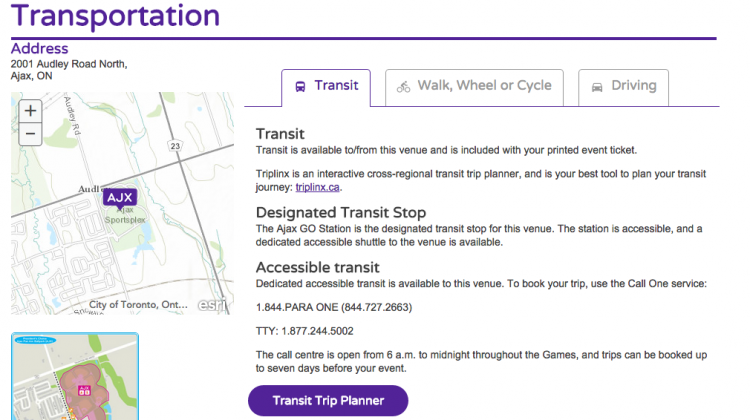In just over a month, Toronto will be hosting the Pan Am Games (July 6-26) and Para-Pan Games (August 6-15). International events like this require extraordinary efforts to get athletes, media, and spectators to their events on time. When Vancouver hosted the 2010 Olympics, planning started years before the event, and planners learned from experts who had hosted Olympic Games in their own regions.
The Pan Am Games won’t draw the millions that the Olympics did: about 250,000 spectators and 6,100 athletes are expected, compared to 500,000 spectators and 2,700 athletes at the Olympics. But Torontonians have experienced travel delays for years from construction of the athletic facilities in Milton, Hamilton, Mississauga, Ajax, and other municipalities in the region.
The transportation demand management measures introduced for the Pan Am Games were just announced today, less than a month before the Games begin. They include:
- Encouraging people to work at home, carpool, and work flex hours
- Installing more HOV lanes on Highway 401, Highway 404, the DVP, Lake Shore Boulevard, the Gardiner Expressway and the QEW, which will require drivers to have three persons or more per car to use from June 29 to July 27. From July 28 to August 18 this will decrease to two or more persons per car
- Providing extra TTC and GO services will also include services starting at 6am on Sundays. Ticketholders will be able to take transit for free on the day of their events
Because of the venues are spread across the region, the Games transit network includes Brampton Transit (Züm), Burlington Transit, Durham Region Transit (DRT), GO Transit (rail and bus), Hamilton Street Railway (HSR), Milton Transit, MiWay (Mississauga Transit), Oakville Transit, Toronto Transit Commission (TTC), St. Catharines Transit, Welland Transit, and York Region Transit (YRT)/Viva.
You can find out about the Pan Am venues on the Pan Am Games website, www.toronto2015.org. This screenshot shows the transportation options for the baseball venue in Ajax.

Skeptical that transit can handle the extra bodies, Toronto residents? You should be. Just yesterday, a power surge forced the entire subway system shut down for 95 minutes, stranding 100,000 commuters during morning rush hour. The TTC normally deploys shuttle buses when the subway fails, but couldn’t supply enough vehicles to replace all four lines. With no backup plan in place, the massive communications failure that took out all the subway trains but left buses and streetcars running left both residents and politicians shaking their heads. Toronto’s transportation system is so poorly funded and organized that even Mayor John Tory, who campaigned on a public transit plan for the city, could merely apologize to commuters for the inconvenience. Taxi companies rushed to send cars to subway stations to serve stranded commuters and Uber’s surge pricing caused its rates to quadruple in some parts of the city. The same day, starting at 9:25am, three Toronto Star reporters raced from Broadview Avenue to the airport to see who would make it first: Tess Kalinowski drove, Steven Spencer Davis took transit (TTC) and Lauren Pelley took the newly opened Union-Pearson Express. Kalinowski got to the airport in half the time of Pelley (40 minutes versus 80 minutes). What does this say about our alternative transportation options for travel during the Games?
When I lived in Vancouver during the Olympic Games, many of my friends and acquaintances left the city altogether during the event, renting out their apartments for exorbitant fees. The absence of thousands of regular working folks, the agreement many companies and institutions made to adjust to flex hours during the two-week event, and residents’ fear of being caught in traffic, took tens of thousands of cars off the roads. Downtown and at venues like Richmond’s speed skating oval, public transit had been carefully coordinated with walking and bike sharing options–tens of thousands of people walked the 20 minutes from the Skytrain to the Oval. In addition to planning and funding these alternative options, TransLink had been advertising these options for almost a year before the Games started. Transit ridership increased by 50% during the Games and remained higher than average for months afterward. Maybe it’s just my own experience, but in Toronto I started seeing ads for carpooling, flex hours and working at home just a few weeks ago, and today was the first that I heard about increased transit during the Games.
Incidentally, carpooling, flex hours, and working at home are TDM measures that are integral to decreasing peak-hour demand (and levelling out the peaks) in any metropolitan region, not just when we’re hosting an international sporting event.
